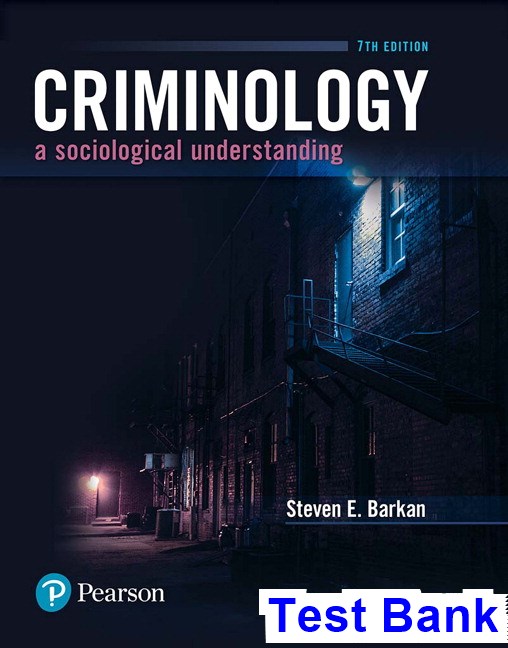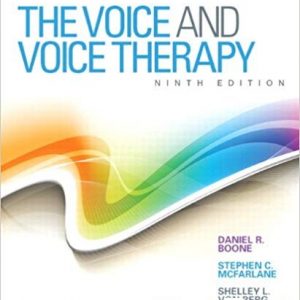Instant download Criminology A Sociological Understanding 7th Edition Barkan Test Bank pdf docx epub after payment.

Product details:
- ISBN-10 : 0134548604
- ISBN-13 : 978-0134548609
- Author: Steven E. Barkan
Criminology: A Sociological Understanding [RENTAL EDITION]
Table of contents:
- Part 1 Understanding Crime and Victimization
- 1 Criminology and the Sociological Perspective
- Learning Objectives
- Chapter Outline
- The Sociological Perspective
- Review and Discuss
- The Mutual Relevance of Sociology and Criminology
- Intersectionality
- Review and Discuss
- The Rise of Sociological Criminology
- Crime, Deviance, and Criminal Law
- Consensus and Conflict in the Creation of Criminal Law
- Goals of Criminal Law
- An Overview of Criminal Law
- Legal Distinctions in Types of Crime
- Criminal Intent
- Legal Defenses to Criminal Liability
- Accident or Mistake
- Ignorance
- Duress
- Self-Defense
- Entrapment
- Insanity
- Review and Discuss
- Research Methods in Criminology
- Surveys
- Review and Discuss
- Experiments
- Qualitative Research: Observing and Intensive Interviewing
- Research Using Existing Data
- Comparative and Historical Research
- Conclusion
- Summary
- Key Terms
- What Would You Do?
- 2 Public Opinion, the News Media, and the Crime Problem
- Learning Objectives
- Chapter Outline
- A Brief Look Back
- Public Opinion and Crime Policy
- Review and Discuss
- News Media Coverage of Crime and Criminal Justice
- Overdramatization of Crime
- Crime Waves
- Overreporting of Crime (Violent)
- Review and Discuss
- Crime Myths
- Racial and Ethnic Minorities
- Youths
- Virtuous Victims
- Review and Discuss
- Other Problems in Media Coverage
- Effects of Media Coverage
- Public Ignorance
- Public Fear and Concern
- Obscuring Underlying Forces
- Diversion from White-Collar Crime
- Racial and Ethnic Stereotyping
- Review and Discuss
- Research on Public Beliefs about Crime and Criminal Justice
- Fear of Crime
- Structural Factors
- Individual Characteristics
- Consequences of Fear
- Review and Discuss
- Seriousness of Crime
- Punitiveness
- The Death Penalty
- Review and Discuss
- Views about the Police
- Perceptions of Criminal Injustice
- Views about Criminal Justice Spending
- A Final Word on Public Beliefs
- Conclusion
- Summary
- Key Terms
- What Would You Do?
- 3 The Measurement and Patterning of Criminal Behavior
- Learning Objectives
- Chapter Outline
- Measuring Crime
- Uniform Crime Reports
- How a Crime Becomes Official
- Critique of UCR Data
- Underestimation of the Amount of Crime
- Diversion of Attention from White-Collar Crime
- Misleading Data on the Characteristics of Arrestees
- Citizens’ Reporting of Crime
- Police Recording Practices and Scandals
- Different Definitions of Crimes
- School Reporting Practices
- NIBRS and Calls to the Police
- National Crime Victimization Survey
- Evaluating NCVS Data
- Self-Report Studies
- Critique of Self-Report Studies
- Evaluating UCR, NCVS, and Self-Report Data
- Review and Discuss
- Recent Trends in US Crime Rates
- Patterning of Criminal Behavior
- Geographical Patterns
- International Comparisons
- Review and Discuss
- Comparisons Within the United States
- Seasonal and Climatological Variations
- Social Patterns of Criminal Behavior
- Gender and Crime
- Explaining Women’s Low Crime Rates
- Are Girls and Women Becoming More Violent?
- Review and Discuss
- Race, Ethnicity, and Crime
- Explaining African American Crime Rates
- Latinos and Other Groups
- Immigrants
- Review and Discuss
- Social Class and Crime
- Review and Discuss
- Age and Crime
- Explaining the Age–Crime Relationship
- Gender, Race, and Age Combined
- Chronic Offenders and Criminal Careers
- Conclusion
- Summary
- Key Terms
- What Would You Do?
- 4 Victims and Victimization
- Learning Objectives
- Chapter Outline
- Defining Victims and Studying Victimization
- Review and Discuss
- The Patterning of Victimization
- Geographical Patterns
- Social Patterns
- Gender, Race, and Ethnicity
- Family Income
- Age
- Race, Gender, and Age Combined
- Review and Discuss
- Victim–Offender Relationship
- Strangers Versus Nonstrangers
- Intimate-Partner Violence
- Perceived Race, Gender, and Age of Offenders
- Review and Discuss
- Crime Characteristics
- Use of Alcohol and Other Drugs
- Time and Place of Occurrence
- Use of Weapons
- Victim Self-Protection and Resistance
- Explaining Victimization
- Lifestyle and Routine Activities Theories
- Deviant Lifestyles and Victimization
- Review and Discuss
- Physical Proximity and Victimization
- Review and Discuss
- Individual Traits
- Low Self-Control and Lack of Social Relationships
- Childhood Problems
- Mental Disorder
- Puberty
- Repeat Victimization
- Explaining Sociodemographic Variation in Victimization
- Review and Discuss
- Victimization of College Students and the Homeless
- College Students
- The Homeless
- Costs and Consequences of Victimization
- Economic and Medical Costs and Consequences
- Psychological Consequences
- Social and Behavioral Consequences
- Review and Discuss
- Victims in the Criminal Justice System
- Victims and Criminal Case Outcomes
- Victimization by White-Collar Crime
- Conclusion
- Summary
- Key Terms
- What Would You Do?
- Part 2 Explaining Crime
- 5 Classical and Neoclassical Perspectives
- Learning Objectives
- Chapter Outline
- Understanding Theories of Crime
- From Theology to Science
- God and Demons as Causes of Crime and Deviance
- The Age of Reason
- The Classical School of Criminology
- Review and Discuss
- The Rise of Positivism
- Neoclassical Perspectives
- Rational Choice Theory
- Evaluating Rational Choice Theory
- Deterrence Theory
- Types of Deterrence
- Taking a Closer Look at Deterrence
- Research on Deterrence
- Routine Activities Theory
- Evaluating Routine Activities Theory
- Theory and Policy
- Conclusion
- Summary
- Key Terms
- What Would You Do?
- 6 Biological and Psychological Explanations
- Learning Objectives
- Chapter Outline
- Biological Explanations
- Nineteenth-Century Views
- Phrenology
- Cesare Lombroso: Atavism
- Lombroso on Women
- Early Twentieth-Century Views
- Earnest Hooton: Biological Inferiority
- William Sheldon: Body Shapes
- Contemporary Explanations
- Family, Heredity, and Genes
- Early Research
- Twin Studies
- Adoption Studies
- Molecular Genetics
- Evolutionary Biology
- Chromosomal Abnormalities
- Brain Abnormalities
- Neurochemical Factors
- Hormones: Testosterone and Male Criminality
- Hormones: PMS and Crime by Women
- Neurotransmitters
- Nutrition and Diet
- Pregnancy and Birth Complications
- Early Puberty
- Evaluation of Biological Explanations
- Review and Discuss
- Psychological Explanations
- Psychoanalytic Explanations
- Moral Development and Crime
- Intelligence and Crime
- Race, IQ, and Crime
- Review and Discuss
- Personality and Crime
- Evaluation of Psychological Explanations
- Abnormality or Normality?
- Theory and Policy
- Review and Discuss
- Conclusion
- Summary
- Key Terms
- What Would You Do?
- 7 Sociological Theories: Emphasis on Social Structure
- Learning Objectives
- Chapter Outline
- The Legacy of Durkheim
- Review and Discuss
- Social Disorganization and Social Ecology
- Clifford R. Shaw and Henry D. Mckay
- Critiques of Social Disorganization Theory
- The Revival of Social Disorganization Theory
- Other Ecological Work
- Extreme Poverty and Crime
- Kinds of Places Versus Kinds of People
- Review and Discuss
- Anomie and Strain Theory
- Evaluation of Anomie Theory
- Defense and Extension of Anomie Theory
- General Strain Theory
- Review and Discuss
- Subcultural Theories
- Albert K. Cohen: School Failure and Delinquent Subcultures
- Evaluation of Cohen’s Status Frustration Theory
- Walter B. Miller: Focal Concerns
- Evaluation of Miller’s View
People also search:
Criminology A Sociological Understanding 7th Edition
Criminology A Sociological Understanding 7th Edition pdf
Criminology A Sociological Understanding
sociological criminology definition
sociological criminology example
what is sociological theory in criminology





